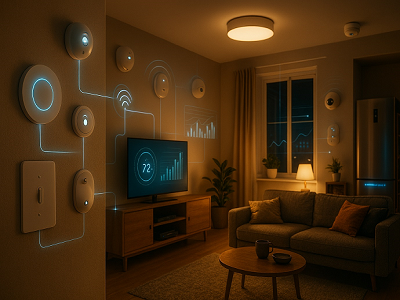
Imagine a house that thinks for itself. It manages its own energy use. It keeps your family completely secure. This vision is the promise of home automation. In 2025, that promise is rapidly turning into reality. The global market is undergoing a major transformation. This change is driven by AI, sustainability, and new government rules. We will dive into the top global developments. We will also explore the exciting innovations happening in India.
Beyond Convenience: Why Home Automation Matters
Home automation is far more than a luxury today. It focuses on sustainability, efficiency, and security. Smart homes use sensors, IoT devices, and AI effectively. They manage everything from appliances to lighting and security. The result is better comfort and a smaller carbon footprint. This also means lower monthly energy bills for you.
Globally, governments and major industries are investing heavily. They are creating smart home ecosystems. These efforts support climate goals and digital transformation plans. India is quickly joining this movement. New policies and players are driving rapid adoption.
Global Tech: AI Meets Energy Management
Innovation in energy is leading the global charge. Researchers are making homes truly intelligent. The goal is to make your house an active part of the smart grid.
NREL’s Foresee™: A Smarter Home Brain
The U.S. National Renewable Energy Laboratory (NREL) has a major project. It is called Foresee™. This is an advanced Home Energy Management System (HEMS). Foresee™ learns your family’s unique habits. It then optimizes energy use across all your devices. This includes solar panels and batteries. This smart system could save U.S. homes $10 billion annually. That translates to a 5–12% saving per house. Foresee™ helps your house communicate with power utilities. This vital link reduces stress on the electrical grid.
ORNL’s Smart Grid Integration
Oak Ridge National Laboratory is also focusing on HEMS. They would now emphasize the role of HEMS in the efficient performance of a smart grid. It is characterized by the scheduling of appliances, their control, strong cybersecurity of IoT devices, and AI-driven analytics that track energy use and optimize it. These US innovations thus create homes not merely connected but intelligently adaptive.
India’s Smart Leap: Policy Drives Progress
India is quickly emerging as a major market leader. Government policy is providing a crucial framework. This ensures security and efficiency for all smart homes.
BEE’s National Smart Home Roadmap
The Bureau of Energy Efficiency is leading from the front. They came up with a roadmap for home automation technologies. This is aimed at increasing residential energy efficiency. Such a roadmap advocates for pilot programs. Besides, it lays out the technology adoption frameworks. The aim will be to make the manufacturers aligned with India's goals of sustainability. In this way, your smart home is energy-efficient by design.
TEC’s IoT Security Standards
Security is a primary concern for everyone. This fear was addressed by the Telecommunications Engineering Centre, popularly known as TEC. The TEC published the Code of Practice for Securing Consumer IoT, TEC 31318:2021. This is an essential code that all smart devices need to have. The code will enforce secure default credentials, strong vulnerability management, and data encryption with integrity. This move ensures homes remain secure as they become smarter.
Global Home Automation Market Momentum
The global home automation market is exploding. Market projections show huge growth ahead. The market should grow from $89.11 billion in 2024 to $183.80 billion by 2031. This is a very strong Compound Annual Growth Rate (CAGR) of 11.2%.
Two segments lead consumer demand worldwide. They are security and access control systems. Wireless networking is also extremely popular. Asia-Pacific, including India, is a high-growth region. This growth is driven by smart city initiatives and rapid urbanization. Big global players like Siemens and Honeywell are key market leaders.
Indian Powerhouses: Local Innovation
India’s market is now buzzing with innovative solutions. Local players and global brands are competing intensely. They offer solutions designed for Indian homes.
- Schneider Electric India offers the Wiser Smart Home ecosystem. It provides hub-free integration with popular voice assistants.
- Havells India provides IoT-enabled dimmers and smart switches. They have a strong distribution and easy retrofit options.
- Tata Power EZ Home focuses on plugs and motion sensors. They target real-time energy monitoring and reduction.
- Smart Node offers a unique advantage. They provide AES-128 encrypted smart panels. They also host servers locally for enhanced data privacy.
These companies show that home automation is becoming accessible. They are creating secure, affordable retrofit solutions.
The Next Wave: Key Future Trends
A number of major trends will shape the future of home automation.
The main theme now is Energy Efficiency. The initiatives taken globally and in India are keeping this core value at the forefront. Secondly, Cybersecurity takes the center stage. The TEC code promises better consumer trust. Thirdly, interoperability is important.
Adoption of the Matter protocol will allow devices to work together better. Finally, AI and Predictive Automation are driving performance. Systems will anticipate your needs and learn your routines.
What’s Next: A Truly Adaptive Home
The future of home automation involves intelligent ecosystems. These systems will blend several functions. These systems will blend several functions. Energy optimization through AI will be one key function. Secure IoT frameworks will protect all consumer data. Affordable retrofit solutions will also offer mass appeal. India's standards alignment and adoption acceleration is key. We expect a surge in innovative products and partnerships. The next decade promises homes that are truly smart, secure, and sustainable.







